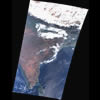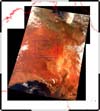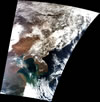Update
 | Images | Title / Summary |
| 21-Feb-2003 |  | The first image obtained from "Midori-II"/GLI via "Kodama", the data relay test satellite.
|
| 18-Feb-2003 |  | Burning hot Australia
|
| 17-Feb-2003 |  | Ocean observations by GLI 250-m visible bands
|
| 17-Feb-2003 |  | Ocean observations by GLI 250-m visible bands
GLI has six 250-m channels from visible to short-wave infrared. The hi-resolution images can provide us new information along the coastal area especially.
|
| 17-Feb-2003 |  | Sea surface temperature in the East China Sea
GLI sea surface temperature is derived using channels 34 (8.6um), 35 (10.8um), 36 (12um). Unlike microwave, infrared information from the sea surface is often obscured by clouds. However, it gives us more details of the thermal structures (e.g., sharp temperature front in the west of Taiwan).
|
| 14-Feb-2003 |  | The Antarctic captured by GLI
|
| 14-Feb-2003 |  | Iceland captured by GLI
|
| 10-Feb-2003 |  | East Asia, mouth of Yangtze River and coastal zone of East China Sea observed by GLI
|
| 07-Feb-2003 |  | 3D structure of a cloud system from GLI data analysis
|
| 03-Feb-2003 |  | Focus on Kyushu : Processing on the first 250 m resolution GLI image
|
| 31-Jan-2003 |  | Bushfires in Southeast Australia on January 25, 2003
Global Imager (GLI) captured severe bushfires in Southeast Australia (New South Wales and Victoria State) at about 13:20UT on January 25, 2003. An infrared channel (3.715µm) of GLI can detect high temperature at the surface. Red portions on the figure represent high temperature at the surface, which can be corresponding to bushfires. |
| 27-Jan-2003 |  | GLI First-light images: GLI capturing the Kyushu Island, southern Japan, and the East China Sea / a great winter cyclone
|

